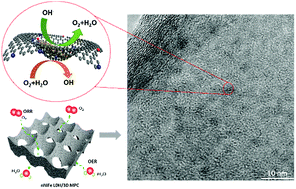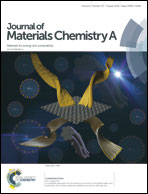NiFe LDH nanodots anchored on 3D macro/mesoporous carbon as a high-performance ORR/OER bifunctional electrocatalyst†
Abstract
Low electric conductivity and low active-site exposure due to the preferable bulk crystallization are among the major obstacles for NiFe layered hydroxides (NiFe LDHs) to be a viable electrocatalyst. Herein, we report the growth of highly loaded (47 wt%) NiFe LDH nanodots (ca. 3 nm) on N-doped three-dimensional (3D) macro/mesoporous carbon (nNiFe/3D MPC). The defect-rich mesopores on the wall of 3D MPC are shown to play a critical role in the high-load and size-limited growth of NiFe LDH, by providing abundant adsorption sites for precursor cations to cause instantaneous nucleation, and at the same time acting as confined reactors for size-limited growth. Also by overcoming the conductivity and active site exposure problems of NiFe LDH, the unique structure of nNiFe LDH/3D MPC evokes intimate interfacial coupling of NiFe LDH and N-doped carbon, and enhanced stabilization of the nanodots through space confinement, making it an excellent bifunctional oxygen electrocatalyst. It exhibits a record low potential gap of 0.71 V between the OER and ORR in 0.1 M KOH for a single non-precious electrocatalyst, with the OER and ORR activity surpassing those of most of the reported NiFe LDHs and N-doped carbons, respectively, and endows a rechargeable Zn–air battery with high power density and durability.



 Please wait while we load your content...
Please wait while we load your content...